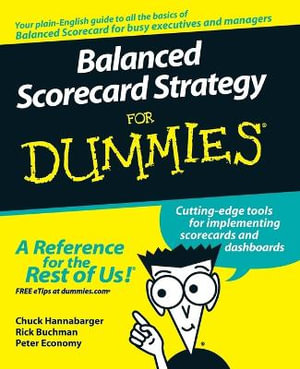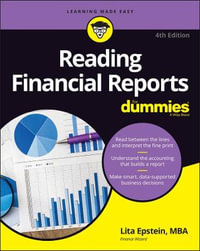
Balanced Scorecard Strategy For Dummies
By: Charles Hannabarger, Frederick Buchman, Peter Economy
Paperback | 24 August 2007 | Edition Number 1
At a Glance
384 Pages
23.49 x 18.71 x 1.95
Paperback
RRP $36.95
$33.25
10%OFF
or 4 interest-free payments of $8.31 with
orAims to ship in 7 to 10 business days
The Balanced Scorecard method is an analysis technique designed to translate an organization's mission and vision statement and overall business strategies into specific, quantifiable goals, and to monitor the organization's performance in achieving these goals.
Much less technology driven then other analysis approaches, it analyzes an organization's overall performance in four regards: financial analysis, customer service, productivity and internal analysis, and employee growth and satisfaction.
Balanced Scorecard Strategy For Dummies breaks down the basics of Balanced Scorecard in simple language with practical, Dummies-style guidance on getting it done. This book covers all the basics of Balanced Scorecard for busy executives and managers-and does it without the high price tag of most professional level Balanced Scorecard guides.
Introduction 1
About This Book 2
Conventions Used in This Book 2
What You’re Not to Read 3
Foolish Assumptions 3
How This Book Is Organized 3
Part I: The ABC’s of Balanced Scorecard 3
Part II: The Customer — The Critical Leg 4
Part III: Financial Measurement — The Foundation Leg 4
Part IV: Internal Business Processes — The Value Creation Leg 4
Part V: Knowledge, Education, and Growth — the Learning Leg 4
Part VI: The Part of Tens 5
Icons Used in This Book 5
Where to Go from Here 5
Part I: The ABC’s of Balanced Scorecard 7
Chapter 1: Goals, Scores, and the Balanced Scorecard 9
Getting Familiar with Balanced Scorecard 10
Just what is Balanced Scorecard, anyway? 10
Leaning on the four legs of the scorecard 10
Achieving Organizational Balance 11
Analyzing Your Customers: Critical Leg 12
Knowing who you sell to 12
Focusing on future customers 13
Considering your internal customers 14
Following the Money: Foundation Leg 14
Measuring your financial health 15
Common mistakes made in finance 17
Tracking Your Internal Business Processes: Value-Creation Leg 18
Assessing the current state of your business 18
Installing effective measures for tracking processes 19
Anticipating your business’s future state 20
The top five process-tracking problems 20
Managing Company-wide Knowledge, Education, and Growth: Learning Leg 21
Understanding the importance of taking care of your own 22
Measuring knowledge, education, and growth 23
Staying on the right course in the fourth leg of the scorecard 25
Using Dashboards to Apply Balanced Scorecards to Your Business 25
Market, environmental, and technology considerations for your dashboards 27
Reviewing strategy, operational, and tactical scorecards and dashboards 28
Chapter 2: Building and Balancing Scorecard Strategies 31
Understanding How the Four Legs Interact and Link to Strategies 32
Putting strategies in the driver’s seat 32
Focusing resources on your strategies 33
Borrowing from Other Companies’ Success 34
Translating strategies into operational terms 35
Aligning your organization to the strategies 36
Making strategies everyone’s daily job 36
Turning strategic deployment into a continual process 36
Mobilizing change through your executive leadership team 37
Developing Your Strategy Map: A Balancing Act 38
Doing your mapping homework 38
Drafting the strategy map 39
Ensuring a Balanced Scorecard (And What to Do When Yours Isn’t) 40
Adapting to Changes in Your Markets or Business 43
Spotlighting external influences and their effect on your business 43
Recognizing early warning signals 47
Balancing in today’s environment — a moving platform 48
Chapter 3: Planning For the Balanced Scorecard 49
Getting Your Planning in Order 49
Planning Your Work and Working Your Plan 51
Planning for the resources you will need 51
Garnering support from management and others 52
Building the Foundation and the Structure of a Scorecard 53
Stacking the building blocks for implementing a scorecard 54
Adding flexibility so you can adjust a scorecard for effectiveness 55
Contingency planning methods 57
Adding the Final Touches 58
Taking care of the details 58
Ensuring that your scorecard is fireproof 59
Performing a final inspection 59
Chapter 4: Putting Your Balanced Scorecard into Action 61
Deciding When to Launch Your Balanced Scorecard 61
The Scorecard passed the pilot, and everyone knows it! 61
The Scorecard is seen as genuinely adding value 62
Sustaining the Balanced Scorecard 62
Promoting the scorecard concept 63
Making scorecard the talk of the town 64
Cooking up the best time to launch 66
Mastering the Art of Communicating Your Balanced Scorecards 66
The view from the top: Senior executives 67
Surviving scorecards as a middle manager 68
Spreading the word from the front line 69
Avoiding communication pitfalls 70
Part II: The Customer — The Critical Leg 73
Chapter 5: Understanding Your Role with Customers 75
Five Things You Must Know about Customers 76
Not all customers are created equal 76
Customers can go away 77
You must master the art of customer service 78
Customers watch you closely 79
Do right by your customer 79
Using Customer Info to Keep Your Customers Happy 80
Gathering info about your customers’ satisfaction levels 80
Being proactive to find out what your customers desire 82
Walking miles (and miles) in your customers’ shoes 84
Setting customer-based strategic measures 84
Linking Customer Measures to Your Strategies, Policies, and Plans 85
Developing customer strategies 85
Creating customer plans and tactics 86
Taking action when your customers don’t get what they want 86
Following Up With Your Customers for Adjustments 87
Chapter 6: Creating a Customer Scorecard 89
Zeroing In on the Right Customer Measures 90
Weeding out the wrong measures 91
Discovering customer measures that matter 91
Understanding customer loyalty 92
Taking customer measurements 94
Getting Dependable Data 96
Hocus, pocus — the focus group 97
Asking all the wrong questions 98
Keeping data charts simple 99
Avoiding Interpretation Pitfalls 100
Drawing wrong conclusions 100
Communicating timely with your customers 102
Reading between the lines 102
Building the Customer Scorecard 103
Strategic-level scorecards 103
Operational-level scorecards 105
Tactical-level scorecards 106
Analyzing a Scorecard and Determining a Course of Action 107
Knowing which way to go 107
Making sure you stay on course 109
Chapter 7: Building the Customer Leg Dashboard 111
Customer Dashboard Fundamentals 112
Dashboard basics 112
Determining ownership and responsibility 113
Taking appropriate action: Who, when and how 114
Building the Customer Dashboard 115
Keeping-it-simple-style dashboards (KISS) 115
High-end dashboards with all the fluff 116
Just-in-time versus just-too-late dashboards 118
Tracking and Analyzing the Customer Dashboard 120
Figuring out who needs to know 121
Updating the customer dashboard 122
Drilling down to root causes 123
Part III: Financial Measurement — The Foundation Leg 125
Chapter 8: Understanding Your Role in Financial Measurement 127
Five Things You Must Know About Financial Measurement 128
Your financial measures must be accurate and highly dependable 128
Your financial measures must truly reflect the value of your business 129
Your financial measures must cascade easily from top to bottom 131
Your financial measures must be easy to use and explain 132
Your financial measures must adhere to current regulatory and tax laws 134
Finding The Financial Data Gold Mines 135
Scratching the surface of a goldmine 135
Knowing your business equals leveraging your financial data 135
Using key measures to gain a significant competitive edge 136
Turning difficulties to your advantage 137
Measuring and Interpreting with Accuracy 139
Making sure the right people do your measuring 140
Using consistent and dependable measures 141
Avoiding measurement pitfalls 141
Turning Numbers into Information 142
Examining reporting pitfalls 142
Showing financial info simply 143
Linking Financial Measurements To Strategies, Plans And Tactics 144
Financial measurement is dependant on strategic focus 145
What you do depends on what you want 145
Using Failure Mode Effects Analysis (FMEA) to assess risk 146
Chapter 9: Building the Financial Leg Scorecard 149
Key Aspects of Financial Measures 150
Focusing on the right things 150
The WIIFM (What’s in it for me?) station everyone tunes into 151
Timeliness is your competitive edge 152
Financial Measures That Matter 152
Key questions help you see what to measure 153
Selecting key performance indicators (KPIs) 155
Tips for finding key measures 155
How measures differ 156
Ensure competitive success by revisiting measurement 158
Creating The Financial Scorecard 159
Select either a strategic, operational, or tactical level 159
Customizing your financial measures, and how to score them 160
Examining examples 162
A word or two (or three) about information management 166
Interpreting Financial Measures for Balanced Scorecards 168
Understanding scorecard financial measures, and what they tell you 168
Pointing toward additional information and insight 170
Structures for decision making from scorecard financial measure 171
Understanding the Essence of Accuracy 173
Oh no, the numbers are wrong! 174
The right numbers, the wrong analysis 174
Tracking the numbers by automatic pilot 175
Chapter 10: Building the Financial Leg Dashboard 177
The Basics of Financial Dashboards 177
Determining ownership and responsibility of the financials 178
An emphasis on real-time measurement and response 179
Taking appropriate action: Who, when, and how 180
Creating Financial Dashboards That Have Impact 181
Keep it simple, complete, and effective! 182
Types of dashboards 183
Some examples of dashboards that work! 186
Enabling response and adjustment agility and flexibility 189
Avoiding Pitfalls While Designing Dashboards 190
Selecting the wrong measures 190
Organizing goals and objectives poorly 191
Having the wrong number of financial measures 191
Thinking in the short-term thinking 191
Understanding Your Financial Dashboard 192
Make it part of your daily work 193
So what does it mean, and how will I know what to do next? 194
Follow through — it’s what’s for breakfast 196
Part IV: Internal Business Processes — The Value-Creation Leg 197
Chapter 11: Understanding Your Role in Internal Business Processes 199
Five Things You Must Know about Internal Business Processes 200
Waste abounds in your processes 200
Many process measures don’t link to the customer 202
Your measurement system is probably broken 202
Process workers are under-utilized and unappreciated 203
Technology isn’t always the right answer 204
Creating Value 205
Looking at your value streams’ current state 205
Where you want to be when: The future state 206
You Get What You Reward 207
Sending mixed messages 207
Old rewards do not create new behaviors 208
Rewards that matter 209
Building-In Continuous Improvement 210
Process improvement in a nutshell 211
Determining, what, when, and where to measure 211
How to measure your performance 213
Acceptance and ownership means getting everyone involved 213
Pitfalls to Continuous Improvement 215
Implementing continuous improvement 215
Identifying core processes and outsourcing 217
Technology isn’t always the answer 218
The Weakest Links in Internal Business Processes 219
The problem with integrating strategies, plans, and tactics 220
Systems thinking and internal business processes 222
It’s a people thing 224
Tying Internal Processes to Your Strategies, Plans, and Tactics 226
Playing catchball: The art and science of deployment 226
Developing your process strategies, plans, and tactics 227
Chapter 12: Building the Internal Business Process Scorecard 229
Finding the Right Measures for Internal Business Processes 230
Identifying the critical few measures 230
The Input-Process-Output diagram: Your best friend 232
Waste, scrap, and other bad things 233
Where’s the variation? 234
Building Scorecards for Internal Business Processes 235
Strategic level scorecards 235
Operational level scorecards 236
Tactical level scorecards 236
Making Process Decisions That Give Competitive Advantage 239
Involving the right people in process decisions 239
Staying ahead of the competition: Tools that help 240
Common mistakes made with internal business process scorecards 241
Chapter 13: Building Dashboards for Internal Business Processes 243
Understanding Internal Business Process Dashboards 244
The what and why of internal process dashboards 244
Getting to real-time data and information 246
Drilling down to get the gold 247
Creating Your Internal Business Process Dashboards 248
Who should be involved with your dashboards and how 248
Making sure you’re hitting the right targets 250
Ten common mistakes with business process dashboards 251
What Your Internal Business Process Dashboard is Telling You 251
Analyzing your dashboards 252
What to do if you’re not getting there 253
Five common mistakes made in business process dashboard analysis 254
Part V: Knowledge, Education, and Growth — The Learning Leg 255
Chapter 14: Understanding Your Role in Learning and Growth 257
Getting Schooled on Knowledge, Education, and Growth 258
Putting your finger on the elements of productivity 258
Understanding how information flows 260
Examining leadership style and culture 261
Identifying and filling competency needs 262
Aligning your employees organization 263
Have a Clear Direction for the Future 264
Growing means changing: the concern of complacency 265
Getting clarity from learning and growth chaos 266
Having a plan for growth and development 267
Knowing and Understanding Liabilities 269
Turning liabilities into assets, weaknesses into strengths 270
The dangers of shortcutting training for growth 272
Inventorying Knowledge, Skills, and Abilities 273
Your company’s wish list: Defining what you need 274
Step away from the office! Getting to know your people 275
Mind the gaps: Determining knowledge and skill gaps and filling them 277
Linking Your Strategies, Operations, and Tactics for Learning and Growth 280
Balancing at the strategic level for organizational knowledge and growth 281
Having an operational focus for the future 282
Acting tactically for growth, capability improvement, and retention 283
Chapter 15: Creating the Knowledge, Education, and Growth Scorecard 285
Finding The Right Measures For Knowledge, Education And Growth 286
Determine key growth goals for the future 286
Identifying operational goals, measurements for growth 287
Indicators at the action level 288
Constructing The Knowledge Management Growth Scorecard 291
Aligning key growth measurements, for strategies and their impact 291
Determining the right measures for today and tomorrow 292
Always reassess and adjust, per market changes as well 293
Some examples of growth and development scorecards 294
Determining What Your Scorecard Is Telling You 300
How to read your future 301
Adjusting when it’s not what you want 302
Some mistakes to avoid in interpretation 303
Chapter 16: Creating The Knowledge, Education, and Growth Dashboard 305
Requirements For Knowledge, Education, and Growth Dashboards 306
Translating growth goals into meaningful daily measures 306
Selecting key short- and long-term measures 307
Wait! It’s time to do a sanity check! 308
Creating Dashboards That Increase Knowledge Management 309
Formulating the structure of your growth dashboard for action 309
Setting up feedback systems 311
Using the dashboard to achieve greater potential 311
Analyzing Your Knowledge, Education And Growth Dashboard 312
How to use the growth dashboard to make adjustments to scorecard balance 313
What your dashboard is telling you as you work toward achieving your future 314
The importance — and the risks — of being truthful 315
Understanding the Pitfalls of Analysis 316
Performance results alone do not a benchmark make 317
Comparing apples and elephants: best practices where? 318
Beware of cookbook approaches and case studies 319
Part VI: The Part of Tens 321
Chapter 17: Ten Tips for Balanced Scorecard Success 323
Establish (and Remember) Where Your Company is Headed 323
Understand and Stay Current with What Your Customers Want 324
Define Your Scorecard and Dashboard Roles and Responsibilities 325
Charter Effective Steering Committees 325
Establish and Maintain Accountability 326
Link Your Scorecards and Dashboards to Your Strategies, Goals, and Objectives 326
Communicate Your Personalized Four - Legs Approach to Everyone 327
Use Feedback and Feed-Forward Loops 327
Plan and Execute Your Balanced Scorecards Relentlessly 328
Synergize Your Scorecards for Competitive Advantage and New-Market Entrance 329
Chapter 18: Ten Biggest Scorecard Mistakes to Avoid 331
Cherry Picking 331
Following Case Studies Too Closely 332
Delegating Responsibility without Authority 333
Ignoring the Soft Stuff 333
Focusing Too Much on the Tools 335
Overanalyzing 335
Not Dealing with Key Detractors 336
Sending Mixed Messages 337
Exaggerating the Returns 337
Ignoring the Customer 338
Chapter 19: Ten Tips for Overcoming Barriers 339
Empower Your Employees 339
Be Flexible 341
Apply Psychology 341
Identify and Use Influential People 342
Limit the Use of Force 342
Don’t Shoot the Messenger; Make Everyone the Messenger 342
Implement Stage-Gate Reviews 343
Reward, Recognize, and Celebrate Success 343
Communicate, Communicate, Communicate (And Don’t Forget to Talk) 344
Provide Structure for Coaching, Mentoring, and Learning from Mistakes 344
Index 345
ISBN: 9780470133972
ISBN-10: 047013397X
Series: For Dummies
Published: 24th August 2007
Format: Paperback
Language: English
Number of Pages: 384
Audience: General Adult
Publisher: John Wiley & Sons Inc (US)
Country of Publication: GB
Edition Number: 1
Dimensions (cm): 23.49 x 18.71 x 1.95
Weight (kg): 0.58
Shipping
| Standard Shipping | Express Shipping | |
|---|---|---|
| Metro postcodes: | $9.99 | $14.95 |
| Regional postcodes: | $9.99 | $14.95 |
| Rural postcodes: | $9.99 | $14.95 |
How to return your order
At Booktopia, we offer hassle-free returns in accordance with our returns policy. If you wish to return an item, please get in touch with Booktopia Customer Care.
Additional postage charges may be applicable.
Defective items
If there is a problem with any of the items received for your order then the Booktopia Customer Care team is ready to assist you.
For more info please visit our Help Centre.
You Can Find This Book In
This product is categorised by
- Non-FictionBusiness & ManagementBusiness Strategy
- Non-FictionSelf-Help, Personal Development & Practical AdviceHow-toFor Dummies BooksBusiness & Finance General Business & Finance Reference
- Non-FictionBusiness & ManagementManagement & Management TechniquesManagement Decision Making
- Non-FictionSelf-Help, Personal Development & Practical AdviceHow-toFor Dummies BooksBusiness & Finance Business Productivity























